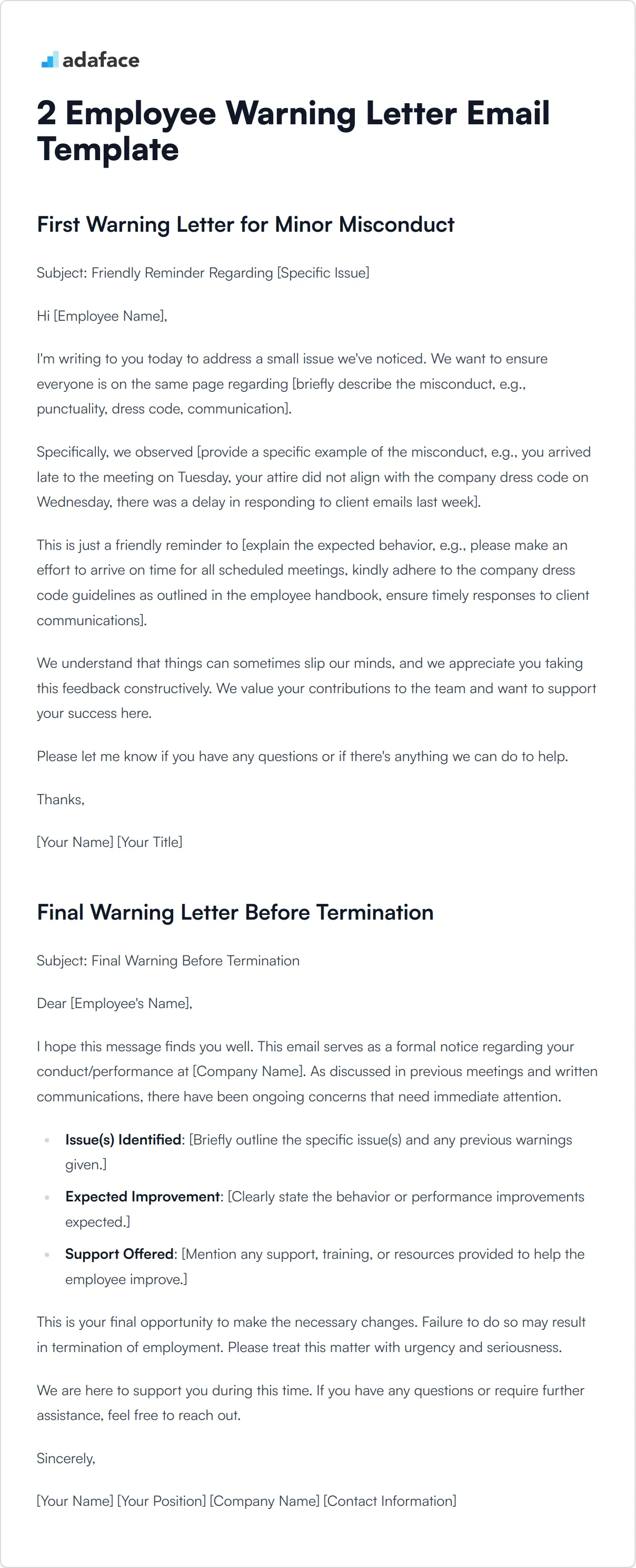Handling employee misconduct requires tact and clarity. A well-crafted warning letter can address issues while maintaining professionalism. Our templates help you navigate these challenging situations.
From minor infractions to poor performance, each template is designed to communicate effectively. Avoid common pitfalls and ensure your message is clear and constructive.
Table of contents
Crafting a Clear and Constructive Warning Letter
A well-structured employee warning letter email sets the tone for addressing performance issues. It's important to strike a balance between firmness and support, ensuring the message is clear while maintaining a professional relationship.
Start with a clear subject line that indicates the email's purpose. Something like 'Performance Improvement Discussion - [Employee Name]' conveys the seriousness without being overly alarming.
The opening paragraph should briefly state the reason for the warning. Mention specific incidents or behaviors that have led to this point, providing dates and contexts where possible.
Next, outline the company's expectations and how the employee's actions have fallen short. Be specific about what needs to change and provide clear, achievable goals for improvement.
Include a section detailing the consequences if the behavior continues. This could range from further disciplinary action to potential termination, depending on the severity of the issue.
End on a constructive note, offering support and resources to help the employee improve. This could include mentoring, additional training, or regular check-ins to monitor progress.
Finally, request an acknowledgment of receipt and understanding from the employee. This ensures they've read and comprehended the warning, which is crucial for documentation purposes.
First Warning Letter for Minor Misconduct
This template is used when addressing a first-time minor misconduct by an employee. It serves as a gentle reminder to correct the behavior while maintaining a positive tone.
Subject: Friendly Reminder Regarding [Specific Issue]
Hi [Employee Name],
I'm writing to you today to address a small issue we've noticed. We want to ensure everyone is on the same page regarding [briefly describe the misconduct, e.g., punctuality, dress code, communication].
Specifically, we observed [provide a specific example of the misconduct, e.g., you arrived late to the meeting on Tuesday, your attire did not align with the company dress code on Wednesday, there was a delay in responding to client emails last week].
This is just a friendly reminder to [explain the expected behavior, e.g., please make an effort to arrive on time for all scheduled meetings, kindly adhere to the company dress code guidelines as outlined in the employee handbook, ensure timely responses to client communications].
We understand that things can sometimes slip our minds, and we appreciate you taking this feedback constructively. We value your contributions to the team and want to support your success here.
Please let me know if you have any questions or if there's anything we can do to help.
Thanks,
[Your Name] [Your Title]
Second Warning Letter for Repeated Offenses
Utilize this template when an employee has repeated the same misconduct despite a prior warning. It emphasizes the need for immediate improvement to avoid further consequences.
Subject: Second Warning Regarding [Specific Offense] - Immediate Improvement Required
Dear [Employee Name],
This letter serves as a second and final warning regarding your [Specific Offense], which occurred on [Date of Offense]. This follows our previous warning issued on [Date of First Warning] concerning the same issue.
We previously discussed [ Briefly mention the issue and the expected behavior]. Despite this discussion and the prior warning, this behavior has unfortunately continued.
Specifically, [Describe the recent incident in detail. Be factual and avoid assumptions].
Please understand that this behavior is unacceptable and violates company policy [Mention specific policy if applicable]. Continued repetition of this offense will lead to further disciplinary action, up to and including termination of employment.
We expect immediate and sustained improvement in this area. To support you, we are offering [Mention any support offered, e.g., additional training, mentorship, etc.].
Please schedule a meeting with [HR Contact/Manager Name] by [Date] to discuss this matter further and create a plan for improvement. You can reach them at [Phone Number] or [Email Address].
We hope that you will take this warning seriously and take the necessary steps to correct your behavior. We value your contributions to the team and want to see you succeed.
Sincerely,
[Your Name] [Your Title] [Company Name]
Final Warning Letter Before Termination
This template is for serious or repeated offenses that may lead to termination if not corrected. It outlines the final opportunity for the employee to improve their behavior.
Subject: Final Warning Before Termination
Dear [Employee's Name],
I hope this message finds you well. This email serves as a formal notice regarding your conduct/performance at [Company Name]. As discussed in previous meetings and written communications, there have been ongoing concerns that need immediate attention.
- Issue(s) Identified: [Briefly outline the specific issue(s) and any previous warnings given.]
- Expected Improvement: [Clearly state the behavior or performance improvements expected.]
- Support Offered: [Mention any support, training, or resources provided to help the employee improve.]
This is your final opportunity to make the necessary changes. Failure to do so may result in termination of employment. Please treat this matter with urgency and seriousness.
We are here to support you during this time. If you have any questions or require further assistance, feel free to reach out.
Sincerely,
[Your Name] [Your Position] [Company Name] [Contact Information]
Warning Letter for Attendance Issues
Use this template to address chronic attendance problems, such as frequent tardiness or absenteeism. It highlights the impact on team performance and the need for improvement.
Subject: Attendance Concern
Dear [Employee's Name],
I hope this message finds you well. I am writing to discuss a concern regarding your attendance record.
We have noticed a pattern of [mention specific issues, e.g., frequent tardiness or absenteeism] over the past [mention time period]. This has affected your ability to contribute effectively to our team and meet your responsibilities.
We understand that unforeseen circumstances can arise, and we are here to support you. However, maintaining regular attendance is important for the smooth operation of our team.
To address this, we would like to schedule a meeting to discuss any challenges you may be facing and explore possible solutions. Please let us know a convenient time for you.
We value your contributions and are committed to working together to improve this situation. Thank you for your attention to this matter.
Best regards,
[Your Name] [Your Position] [Company Name] [Contact Information]
Warning Letter for Poor Performance
This template is aimed at employees not meeting performance expectations. It provides specific areas needing improvement and sets clear goals for future performance.
Subject: Important: Performance Improvement Required
Dear [Employee's Name],
I hope this message finds you well. I am writing to discuss some concerns regarding your recent performance at [Company Name]. We value your contributions, and it is important for us to ensure that everyone is aligned with our performance expectations.
Areas Needing Improvement:
- [Specific Area 1]
- [Specific Area 2]
- [Specific Area 3]
We believe that focusing on these areas will help you succeed in your role. To support you, we have set the following goals:
Performance Goals:
- [Goal 1: Description and Deadline]
- [Goal 2: Description and Deadline]
- [Goal 3: Description and Deadline]
Please let us know if you need any assistance or resources to achieve these goals. We are here to help you improve and succeed.
We will schedule a follow-up meeting on [Date] to review your progress and discuss any additional support you may need.
Thank you for your attention to this matter. We are confident in your ability to improve and look forward to seeing positive changes.
Best regards,
[Your Name] [Your Position] [Company Name] [Contact Information]
Warning Letter for Inappropriate Conduct
Use this template to address unprofessional or inappropriate behavior in the workplace. It stresses the importance of maintaining a respectful work environment for all employees.
Subject: Warning Regarding Inappropriate Conduct
Dear [Employee Name],
This letter is to address concerns regarding your conduct in the workplace. We have received reports and/or observed behavior that violates our company's code of conduct and commitment to a respectful work environment.
Specifically, [Clearly and concisely describe the inappropriate behavior. Be specific with dates, times, and examples. Avoid generalizations].
This behavior is unacceptable because:
- [Explain why the behavior is inappropriate and violates company policy. Refer to specific policies if possible.]
- [Explain the impact of the behavior on other employees and/or the work environment.]
We expect all employees to maintain a professional and respectful demeanor at all times. This includes:
- [List specific expectations for future behavior. Be clear and actionable.]
- [Reinforce the importance of adhering to company policies regarding workplace conduct.]
Please be aware that a repeat of this behavior, or any similar misconduct, may result in further disciplinary action, up to and including termination of employment.
We encourage you to take this warning seriously. We are committed to providing a positive and productive work environment for everyone. We are here to support you in meeting these expectations. Please reach out to [HR Contact/Manager Name] if you have any questions or require clarification.
Sincerely,
[Your Name/HR Department] [Your Title]
Download Employee Warning Letter Email Templates in multiple formats
Decoding Disaster: Common Pitfalls in Warning Letter Emails
Crafting an employee warning letter email isn't just about pointing fingers; it's about fostering improvement. However, recruiters often stumble, turning these emails into sources of conflict rather than catalysts for change. It might be worth it to look at dos and donts for communicating with candidates.
One frequent error is vagueness. A warning letter needs specific examples of the problematic behavior, not general accusations. Without clear details, the employee can't understand what needs fixing.
Another mistake is skipping documentation. Always reference previous conversations or performance reviews related to the issue. This shows a history of addressing the problem, not a sudden, out-of-the-blue attack.
Ignoring the tone is also a common misstep. While direct, the email should remain professional and avoid accusatory language. Focus on the behavior and its impact, not personal attacks.
Finally, failing to outline clear expectations and consequences is a major oversight. The employee needs to know what's expected moving forward and what will happen if the behavior doesn't change. Consider using skills matrix to show the employee where they are lacking.
Wrapping Up
Navigating employee misconduct requires a delicate balance. With these warning letter templates, you're better equipped to address issues and foster a more productive work environment, while ensuring you are following fair hiring practices.
Remember, a well-crafted warning letter serves as a clear roadmap for improvement. Use these templates as a starting point and customize them to fit your specific needs for talent management.
Employee Warning Letter Email Template FAQs
Employee warning letters follow a formal structure to ensure clarity and consistency. This uniformity helps in maintaining a professional tone across different situations.
AI can assist in drafting by providing templates and suggestions, but human oversight is crucial to ensure the message is appropriate and context-specific.
Recruiters should focus on clear communication, specific examples of misconduct, and constructive feedback to avoid misunderstandings and legal issues.
An effective warning letter includes specific examples of the issue, expected improvements, and potential consequences if the behavior continues.
A final warning letter should be issued when previous warnings have not resulted in the necessary behavioral changes, and termination is a possible outcome.

40 min skill tests.
No trick questions.
Accurate shortlisting.
We make it easy for you to find the best candidates in your pipeline with a 40 min skills test.
Try for freeRelated templates




